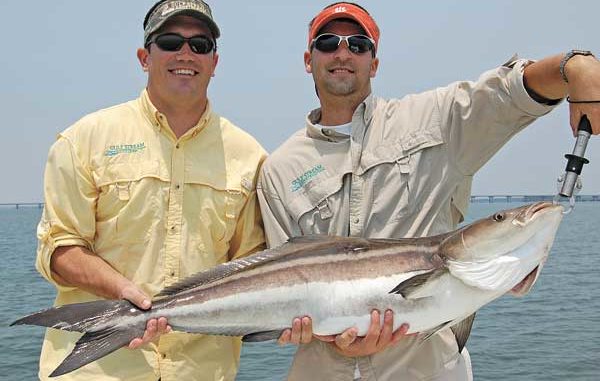
St. Helena Sound is a prime May destination for these hard-charging fish — and the anglers who like to target them.
The pursuit of cobia can challenge saltwater tackle as well a fisherman’s knowledge. This sleek and hardy saltwater fish is quite a fighter and is often overlooked for offering fine table fare.
Cobia can be found infrequently in the waters around Charleston and points north, so to put the odds of encountering a cobia in his favor, the dedicated angler must commit to a day-trip to the south.
For the novice, a cobia (Rachycentron canadum) resembles a shark, having a similar shape and a generally dark skin. They are both slim-bodied fish with a protruding lower jaw. The largest cobia can exceed 100 pounds. They are protected by federal gamefish regulations, which designate a 33-inch size minimum. In addition, the daily creel limit is two fish. Their textured white meat is appealing both to the eye and to the palate.
Having grown up saltwater fishing in the creeks and harbor of Charleston, which includes the “nearshore” fisheries, my fishing friends and I did not discuss cobia because we hardly ever saw one. But a chance encounter with a big cobia while fishing for king mackerel made me aware of the challenge of cobia fishing.
Destiny was both kind and cruel that day, and I dueled with the largest cobia I’ve ever seen, a quest that ended when the fish made a surprise move. After an arduous fight that kept my rod deeply bowed, the cobia took off with the speed and power of a submarine, and my line soon parted. It is the type of experience that is certain to inspire any angler.
The first thing I did after that trip was to speak to other fishermen about cobia. The fact that was most prominent — the one that hit home like a Fort Sumter cannon shot — was that while cobia are great fighters, they are more famous for their “second wind.” Many of the stories involved getting a cobia into the boat, only to have it explode in a muscular fit that would literally clear the decks of coolers, tackle boxes and rods and reels.
Research clearly indicated that the largest showing of cobia in South Carolina is south of Charleston, specifically, just south of Edisto Island in St. Helena Sound, Port Royal Sound and their tributaries. You just come to understand that cobia visit St. Helena Sound.
To a Lowcountry native, the terrain south of Charleston is “God’s country,” so it’s an easy task to make annual trips during May to St. Helena Sound for cobia — especially when captains like Steve Fralin and John Irwin are on the watch.
Fralin runs Ugly Ducklin’ Charters out of Edisto Marina. A former fire chief in Edisto, he’s been guiding for 18 years, sharing his 21-foot boat the past four years with mate David Simmons.
Fralin said, “You need two people on a cobia charter to keep the lines cleared when the sharks are hitting.”
Fralin heads to the cobia grounds through the South Edisto River, Fenwick Cut and the Ashepoo River to St. Helena Sound and the Combahee Light. He likes to anchor up in six to 10 feet of water and fish cut bait, squid or shrimp to catch bluefish or whiting for live cobia baits.
The baits in the livewell, he rigs 6-foot-6 Penn Slammer rods and Penn 330 GT reels with 50-pound Ande mono, a 100-pound mono leader, a 6/0 hook and 8-ounce weight.
He is very specific about the hooks he uses — or doesn’t use. He won’t use stainless steel hooks, because he wants the hooks to rust out of the fish as soon as possible if he gets a break-off, and he won’t use circle hooks.
“I’m not a tree hugger, but nine times out of 10, we release everything we catch,” he said. “We have always released our fish, since before that made us conservationists.”
The biggest cobia to come over the gunwales of Fralin’s boat was a 58-pound fish he caught in May 2007 on a piece of cut mullet. The battle at the Combahee Light was a typical one, because he was just out fun-fishing when the cobia struck. After a bit of a struggle, a 5-foot shark appeared and chased the cobia around. When the cobia came to the gaff, Simmons finished him off with a 2-foot billy club.
Fralin has seen the cobia fishery change over the years. “(It) used to consist of a few folks coming down from Walterboro around May 15 to catch some cobia because they were good eating.”
Nowadays, the cobia run lasts the entire month of May, and it’s not unusual to have fishermen coming from Edisto, Walterboro and Beaufort to St. Helena Sound.
“Now we have to explain to customers about the size limits and bag limits for cobia.” Simmons said, “We have an idea about what baits to use, but we want the customer to be happy, so we are willing to try different baits if that is what they want.”
Irwin operates Fly Right Charters in Charleston, but he rents an apartment in Beaufort to cobia fish through May. An expert fly-fisherman, he guides specifically for cobia during that month and says that the bite in on when the water temperature reaches 70 degrees — his magic number for cobia activity.
The largest cobia tend to be caught during the second and third weeks of the month, he said. Weekends and Memorial Day make for the most boat traffic in St. Helena Sound, so he fishes weekdays only, if at all possible.
The cobia run was different in each of the past three years, Irwin said. In 2006, cooler water temperatures and smaller fish were the rule. In 2007, numbers and big fish were up, but 2008 was a bit of a bust; a nice start, but the cobia never showed up in any great numbers. What will 2009 be like? Irwin will have his lines in the water find out.
He starts trips by catching threadfin herring or “greenies” on Sabiki rigs. Then, he anchors up and sends a chum bag to the bottom with a mushroom anchor.
A big believer in chum, Irwin often makes his own by saving menhaden from summer redfish charters, grinding them up and freezing them in blocks. Irwin also like to take a 22-ounce plastic drink bottle, fill it with menhaden oil, then poke a few holes in it before tying it off behind the boat. Cobia will come right up to the chum bags when hungry, following the scent trail from a great distance. Baits should be placed on that trail.
Another bait option is a specialty bait for cobia: live eels. They are not available at every tackle shop, but they can be special ordered, or you can buy them at B&B Seafood at Bennett’s Point Landing.
Irwin likes to carry a dozen eels and knows a trick or two for handling them. First, he keeps them on ice to keep their hyperactivity to a minimum, and he keeps a box filled with sand to coat the slippery critters before trying to hook them to your line. The current must be running fairly strong to fish with eels and keep them swimming, or else they may tie your line into a huge knot and hurt your chances of getting a bite.
The Combahee Light marks a sandbar at the entrance to St. Helena Sound. Deep water is right off the sandbar, and it’s a great place to fish on an incoming or outgoing tide. Slack tides seem best, so plan on fishing through the turn of the tide and keep an eye for cobia swimming along the surface.
Irwin keeps a rod ready-rigged for pitching bait to a cobia on the surface. The business end of this rig is an Owner SSW 10/0 J-hook, so fishermen can set the hook as soon as the fish bites.
For fishing cut baits on the bottom, Irwin uses a 3- to 4-foot section of 30-pound fluorocarbon, with a sliding sinker just above the swivel. He uses the lightest weight possible to keep his bait on the bottom. He likes a 5/0 Daichi nickel-plated circle hook, which is just the right size for hooking through the nostrils of a greenie — use too small of a hook and the greenie will become fouled.
Irwin fishes a spread of five rods, keeping baits on the bottom, near the surface and in the middle of the water column. He sets the clicker on his reel and exercises patience, waiting for a feeding cobia to take the bait a bit before picking up the rod.
“I wait as long as I can stand it, then I try to wait a bit longer,” Irwin said. “What might be 10 seconds feels like an eternity when you are anticipating that big pull from the cobia.”
Irwin is not opposed to throwing artificial baits at times, including white bucktails, a Rapala CD-11, or a Yo-Zuri stick bait.
Irwin uses a crab-trap buoy on his anchor line because if you hook a big cobia, you untie the boat and chase the fish, and the buoy can mark your spot. Irwin likes to land fish using a boga grip and says to be ready because, “They don’t fight hard until they get in the boat.”

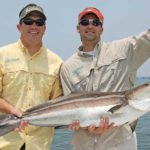
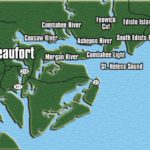
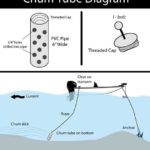
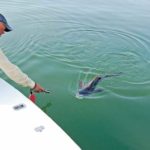
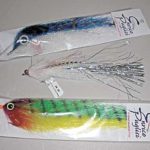
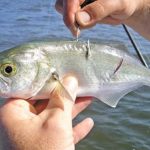
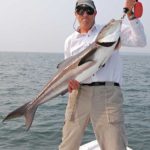


Be the first to comment